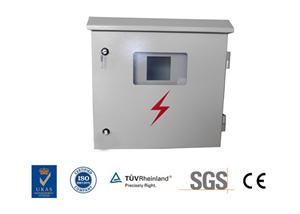ประสบการณ์การดัดแผ่นโลหะ
A: Tonnage ไอออนของเครื่องดัด
ในระหว่างกระบวนการดัดแรงระหว่างแม่พิมพ์บนและล่างถูกนำไปใช้กับวัสดุทำให้วัสดุเปลี่ยนรูปแบบพลาสติก น้ำหนักการทำงานหมายถึงความดันดัดระหว่างการดัด ปัจจัยที่มีอิทธิพลต่อการกำหนดระวางน้ำหนักการทำงาน ได้แก่ รัศมีการดัดวิธีการดัดอัตราส่วนแม่พิมพ์ความยาวข้อศอกความหนาและความแข็งแรงของวัสดุดัดเป็นต้น
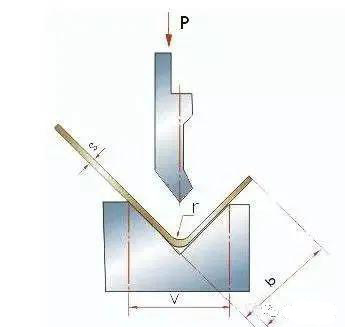
โดยทั่วไประวางน้ำหนักการทำงานสามารถแก้ไขได้ตามตารางต่อไปนี้และตั้งค่าในพารามิเตอร์การประมวลผล
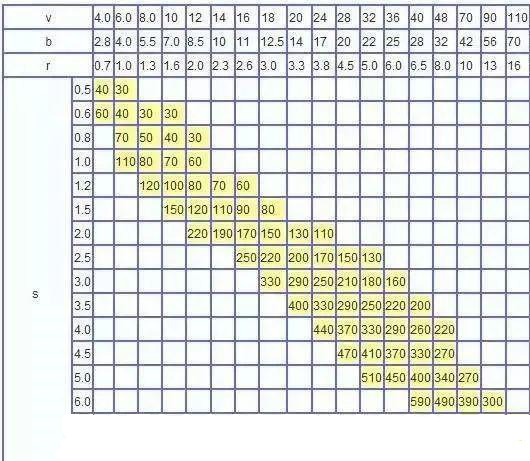
1. ค่าในตารางคือความดันดัดเมื่อความยาวแผ่นเท่ากับหนึ่งเมตร:
ตัวอย่าง: S = 4mm L = 1,000mm V = 32mm
ค้นหาตารางและรับ P = 330kN
2. ตารางนี้คำนวณจากวัสดุที่มีความแข็งแรงσb = 450N / mm2 เมื่อดัดวัสดุอื่นแรงดัดคือผลิตภัณฑ์ของข้อมูลในตารางและค่าสัมประสิทธิ์ดังต่อไปนี้
บรอนซ์ (อ่อน): 0.5;
สแตนเลส: 1.5;
อลูมิเนียม (อ่อน): 0.5;
เหล็กโครเมียมโมลิบดีนัม: 2.0
3. สูตรการคำนวณแรงดัดโดยประมาณ
P = 650s2L / 1000v
P - kn
S - มม
L - มม
V - มม
ตารางเปรียบเทียบความดันดัด
B. ปัญหาที่พบบ่อยในการดัดแผ่นโลหะ
1) แม่พิมพ์ดัดที่ใช้กันทั่วไป
แม่พิมพ์ดัดที่ใช้กันทั่วไปดังแสดงด้านล่าง เพื่อยืดอายุการใช้งานของแม่พิมพ์ชิ้นส่วนได้รับการออกแบบให้มีมุมโค้งมนให้มากที่สุด
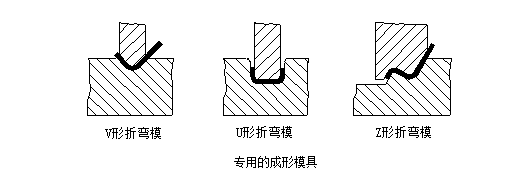
หากความสูงของหน้าแปลนมีขนาดเล็กเกินไปแม้แต่การใช้แม่พิมพ์ดัดก็ไม่เอื้อต่อการขึ้นรูป โดยทั่วไปความสูงของหน้าแปลนL≥3t (รวมถึงความหนาของผนัง)
วิธีการประมวลผลขั้นตอน
สำหรับการดัดงอแบบขั้นตอนแผ่นโลหะรูปตัว Z บางขั้นตอนผู้ผลิตโพรเซสซิงมักใช้แม่พิมพ์ง่าย ๆ ในการเจาะรูหรือกดไฮดรอลิกและแบทช์ขนาดเล็กยังสามารถประมวลผลได้บนเครื่องดัด อย่างไรก็ตามความสูง H ไม่ควรสูงเกินไปโดยทั่วไปควรเป็น (0 ~ 1.0) t หากความสูงเท่ากับ (1.0 ~ 4.0) t คุณจำเป็นต้องพิจารณาการใช้รูปแบบของการเพิ่มและการปล่อยแม่พิมพ์ตามโครงสร้าง ตามสภาพจริง
ความสูงของขั้นตอนแม่พิมพ์นี้สามารถปรับได้โดยการเพิ่ม shims ดังนั้นความสูง H สามารถปรับได้ตามอำเภอใจ แต่ก็มีข้อเสียที่ความยาว L ขนาดนั้นไม่ใช่เรื่องง่ายที่จะรับประกันและแนวตั้งของด้านแนวตั้งไม่ใช่เรื่องง่าย รับประกัน. หากความสูง H ขนาดใหญ่จำเป็นต้องพิจารณาการดัดบนเครื่องดัด
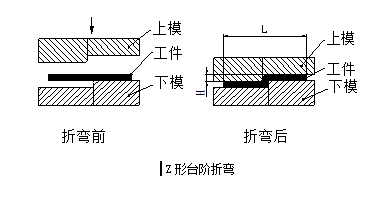
เครื่องดัดมีสองประเภท: เครื่องดัดธรรมดาและเครื่องดัด CNC เนื่องจากความต้องการความแม่นยำสูงและรูปร่างการดัดที่ผิดปกติการดัดแผ่นโลหะของอุปกรณ์สื่อสารจึงโค้งงอด้วยเครื่องดัด CNC หลักการพื้นฐานคือการใช้มีดดัด (บนตาย) และ V- ร่อง (ล่าง) ของเครื่องดัด Die) ดัดและขึ้นรูปชิ้นส่วนโลหะแผ่น
ข้อดี: สะดวกในการจับตำแหน่งที่ถูกต้องและความเร็วในการประมวลผลที่รวดเร็ว;
ข้อเสีย: ความดันต่ำสามารถดำเนินการขึ้นรูปง่ายและมีประสิทธิภาพต่ำ
หลักการพื้นฐานของการขึ้นรูป
หลักการพื้นฐานของการขึ้นรูปแสดงในรูปด้านล่าง:
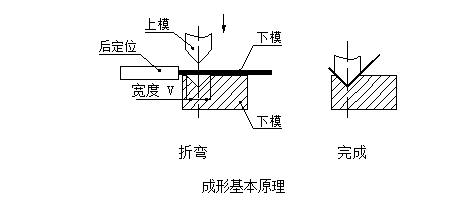
มีดดัด (บนตาย)
รูปแบบของมีดดัดแสดงในรูปด้านล่าง ส่วนใหญ่จะเป็นไปตามรูปร่างของชิ้นงานในระหว่างการประมวลผล โดยทั่วไปแล้วผู้ผลิตแปรรูปมีดรูปร่างหลายรูปแบบโดยเฉพาะผู้ที่มีความเชี่ยวชาญระดับสูง ในการประมวลผลการดัดที่ซับซ้อนต่างๆมีดดัดของรูปร่างและข้อมูลจำเพาะมากมายถูกปรับแต่ง
โดยทั่วไปดายล่างใช้ V = 6t (t คือความหนาของวัสดุ)
There are many factors that affect the bending process, mainly including the radius of the upper die arc, material, material thickness, lower die strength, die size of the lower die and other factors. In order to meet the needs of the product, the manufacturer has already serialized the bending knife mold under the condition of ensuring the safety of the bending machine. We need to have a general understanding of the existing bending knife mold during the structural design process. See the figure below, the upper die is on the left and the lower die is on the right.

Basic principles of bending processing sequence:
(1) Bending from inside to outside;
(2) Bending from small to large;
(3) Bend the special shape first, and then bend the general shape;
(4) After the previous process is formed, it does not affect or interfere with the subsequent process.
The current bending form is generally shown in the following figure:
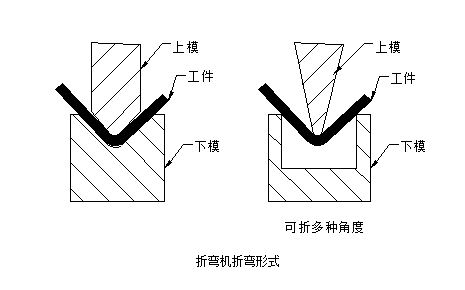
2) Bending radius
When bending sheet metal, a bending radius is required at the bending place. The bending radius should not be too large or too small, and should be ed appropriately. If the bending radius is too small, it is easy to cause cracking at the bending point, and if the bending radius is too large, the bending is easy to rebound. The preferred bending radius (inner bending radius) of various materials with different thicknesses is shown in the table below
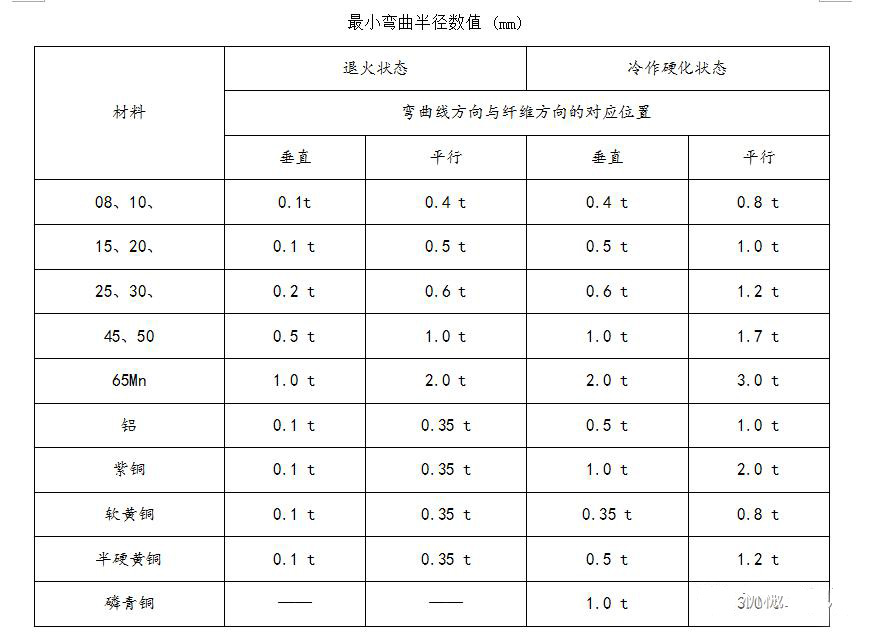
The data in the table above is the preferred data, for reference only. In fact, the corners of manufacturers' bending knives are usually 0.3, and a small number of bending knives are 0.5.
For ordinary low-carbon steel plate, rust-proof aluminum plate, brass plate, copper plate, etc., the inner fillet 0.2 is no problem, but for some high-carbon steel, hard aluminum, super hard aluminum, this bending round It will cause bending breakage or cracking of the outer corners.
3) Bending and rebound
Springback angle Δα = b-a
Where b——the actual angle of the part after rebound;
a—The angle of the mold.
The size of the rebound angle
See the table below for the springback angle when a single angle is 90 ° free bending.
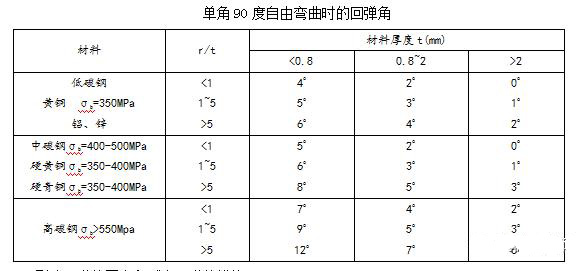
Factors affecting rebound and measures to reduce rebound
① The mechanical properties of the material The rebound angle is directly proportional to the yield point of the material and inversely proportional to the elastic modulus E. For sheet metal parts with high accuracy requirements, in order to reduce springback, the material should be ed as low-carbon steel as possible, not high-carbon steel and stainless steel.
② The larger the relative bending radius r / t, the smaller the degree of deformation and the greater the rebound angle Δα. This is a relatively important concept. The rounded corners of sheet metal bending should be as small as possible, as long as the material properties allow, to improve accuracy. In particular, pay attention to avoid designing large arcs as much as possible, as shown in the following figure, such large arcs have greater difficulty in production and quality control:
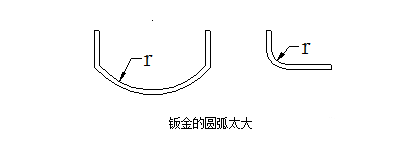
4) Calculation of the minimum bending edge in one bending
The initial state of the L-shaped bend at the time of bending is shown below:
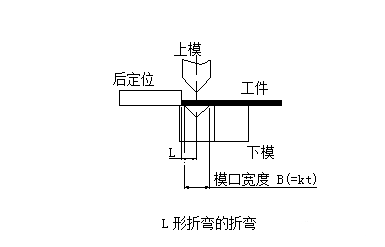
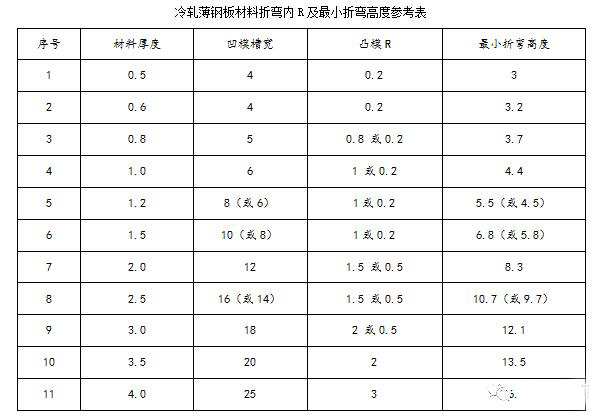
The initial state of the Z-shaped bending at the time of bending is shown in the figure below

The minimum bending dimension L corresponding to the Z-bending of sheet metal with different material thickness is shown in the following table:
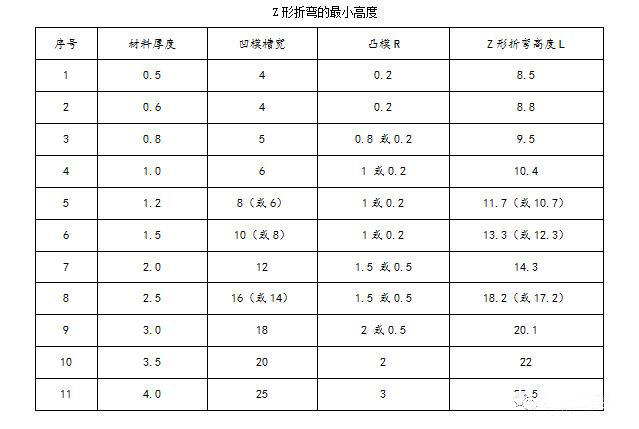
C. Fast calculation method of sheet metal bending and unfolding
When the sheet metal bending and flattening, one side of the material will be elongated and one side will be compressed. The factors affected are: material type, material thickness, material heat treatment and processing bending angle.
Expand calculation principle:
1) During the bending process, the outer layer is subjected to tensile stress and the inner layer is subjected to compressive stress. Between tension and compression, there is a transition layer that is neither tensile nor compressive, called the neutral layer; the neutral layer is bent during the bending process The length is the same as before bending, so the neutral layer is the benchmark for calculating the unfolded length of the bending piece.
2) The position of the neutral layer is related to the degree of deformation. When the bending radius is large and the bending angle is small, the degree of deformation is small. The position of the neutral layer is close to the center of the sheet thickness; when the bending radius becomes small, the bending angle increases When it is large, the degree of deformation increases accordingly, and the position of the neutral layer gradually moves to the inside of the bending center. The distance from the neutral layer to the inside of the sheet is expressed by λ.
On the other hand, with the emergence and popularization of computer technology, in order to make better use of the computer's super analysis and calculation capabilities, people increasingly use computer-aided design, but when computer programs simulate the bending of sheet metal Or it needs a calculation method in order to accurately simulate the process.
Although only to complete a certain calculation, each store can customize a specific program according to its original pinch rules, but nowadays, most commercial CAD and three-dimensional solid modeling systems have provided more general and Powerful solution.
ในกรณีส่วนใหญ่ซอฟต์แวร์แอปพลิเคชันเหล่านี้ยังสามารถเข้ากันได้กับกฎพื้นฐานของประสบการณ์และนิ้วมือหยิกและให้วิธีการปรับแต่งเนื้อหาอินพุตเฉพาะให้เข้ากับกระบวนการคำนวณของมัน SolidWorks ได้กลายเป็นผู้นำในการให้ความสามารถในการออกแบบแผ่นโลหะ




